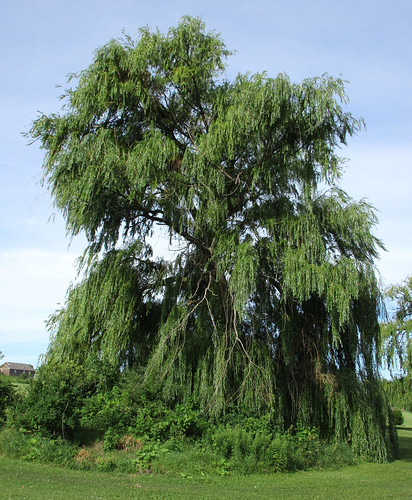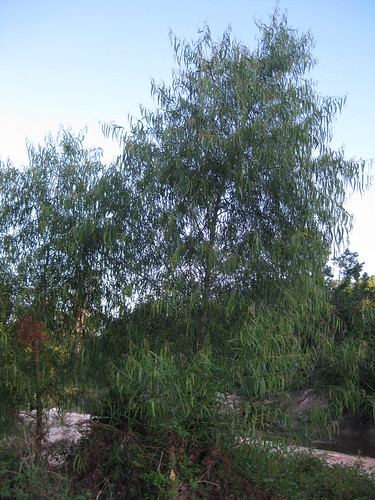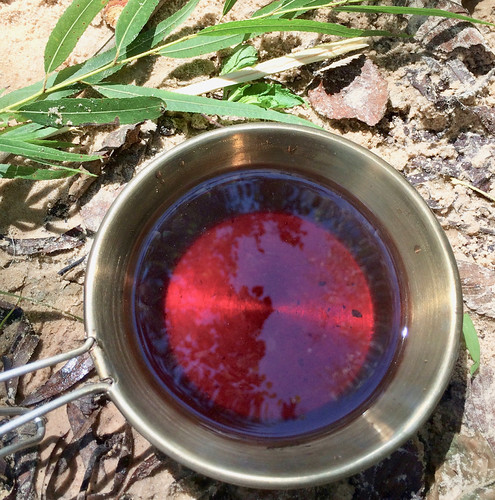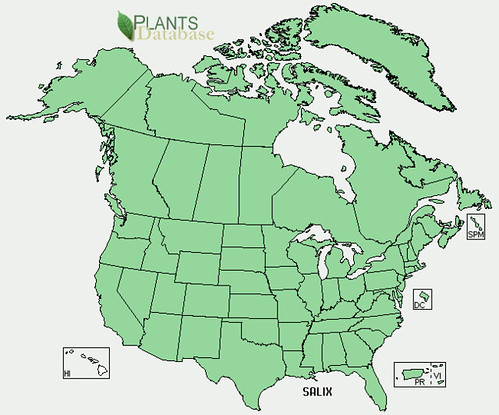Abundance: plentiful
What: twigs, inner bark
How: tea made from chopped up twigs; inner bark is an emergency food and is eaten raw or dried and ground into flour
Where: woods, water, sunny fields, landscaping
When: twigs highest in salicylic acid in early spring; inner bark any time
Nutritional Value: inner bark contains carbohydrates
Dangers: Salicylic acid can cause stomach upset in high doses and trigger Reye's syndrome in young children.
Medicinal Summary:
Young Bark - pain reliever; anti-inflammatory; fever reducer (tisane)
Leaves - soothes skin inflammations (tisane)

Medium-sized willow tree.

Close-up of leaves.

Willow trunk

Boiled willow bark makes a beautiful, red-colored tea that reduces fevers, pain, and swelling due to its salicin converting to salicylic acid. It has a somewhat wintergreen-like flavor.

Texas distribution, attributed to U. S. Department of Agriculture. The marked counties are guidelines only. Plants may appear in other counties, especially if used in landscaping.

North American distribution, attributed to U. S. Department of Agriculture.

The long, wispy branches of willow trees give them an appearance unlike any other tree. They require a lot of water so look for them along wet areas. Their high demand for water can cause problems when used in landscaping as their roots will invade and clog sewer and water pipes.
Willow's main claim to fame is the bark, especially on twigs, contains salicin acid, when it comes in contact with your stomach acid, turns into salicylic acid aka aspirin. This is the original source of the wonder drug but be warned, this tea can also have all the bad effects of aspirin, including Reye's syndrome which can cause dangerous swelling in the brain and liver of children. Start with 1 teaspoon of bark boiled 10 minutes in 1 cup of water, let it cool to a safe temperature, then drink. Multiple cups of this through the day may be needed in severe cases.
The inner bark (cambium layer) can be shredded and chopped then boiled into a porridge to obtain calories. The outer bark of young branches is shredded then made into a tea which contains the precursor of aspirin and will give all the medical benefits (and dangers) of aspirin. The best results are achieved using pencil-thick branches harvested in late winter before the leaves begin to bud.
Willow branches are high in a chemical called Gibberellic acid which is a plant hormone responsible for triggering root growth. The rooting powder and solution purchased in stores to help propagate plant cuttings is this chemical. You can make your own rooting solution by grinding up willow twigs in a clean pencil sharpener then soaking these willow shavings in water (40% willow/60% water) for 5-7 weeks. When you want to propagate a plant via a cutting dip the cutting's stem in this willow solution first.
Dried, shredded willow bark is often added to herbal smoking mixtures to give a heavier flavor more like that of true tobacco.
Buy my book! Outdoor Adventure Guides Foraging covers 70 of North America's tastiest and easy to find wild edibles shown with the same big pictures as here on the Foraging Texas website.

